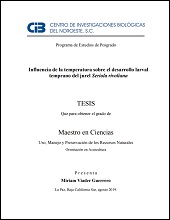| dc.contributor.advisor | MALDONADO GARCIA, MINERVA CONCEPCION | |
| dc.contributor.advisor | GUZMAN VILLANUEVA, LAURA TERESA | |
| dc.contributor.author | VIADER GUERRERO, MIRIAM | |
| dc.date.issued | 2019 | |
| dc.identifier.uri | http://dspace.cibnor.mx:8080/handle/123456789/2986 | |
| dc.description.abstract | "La alta mortalidad larvaria representa uno de los principales problemas del cultivo de peces marinos. Dentro de este contexto, la temperatura juega un papel muy importante ya que tiene un efecto directo en el crecimiento y supervivencia e influye sobre la eclosión, el tiempo de absorción y uso de las reservas energéticas. El objetivo de este trabajo fue determinar el efecto de la temperatura sobre el desarrollo temprano (pigmentación de los ojos y apertura de la boca), la eclosión, calidad bioquímica, tasa de crecimiento y supervivencia larvaria del jurel Seriola rivoliana. Para este experimento se utilizaron desoves naturales, obtenidos de reproductores mantenidos en cautiverio por la empresa Kampachi Farm. Los huevos y larvas fueron sometidos a cuatro temperaturas experimentales: 22, 24, 26 y 28 oC, con 3 réplicas por cada tratamiento. Se evaluaron los siguientes parámetros: (1) porcentaje de eclosión y supervivencia; (2) análisis de imágenes para determinar la longitud notocordal, longitud y altura del saco vitelino, diámetro de la gota lipídica; (3) cuantificación de proteínas y lípidos totales; (4) descripción larvaria de la absorción de las reservas energéticas; y (5) análisis de imágenes para determinar la pigmentación de los ojos, y la apertura de la boca, partiendo desde el estadio del huevo hasta la etapa de preflexión larvaria para todos los tratamientos experimentales. Los resultados muestran un incremento significativo en el porcentaje de eclosión (47%) a 22 oC. Asimismo, se observa un incremento significativo en el porcentaje de supervivencia (13%) a las 48 horas después de la eclosión (HDE) a 24 oC, así como un decremento a 28 oC (4%). El mayor tiempo de supervivencia fue observado a las 120 horas a 22 oC, mientras que a 24 y 26 oC fue de 96 horas. Por otra parte, se observó un incremento significativo en la longitud notocordal (2.784 mm) a 24 oC a las 48 HDE con relación a 22 oC (2.245 mm) y 28 oC (2.089 mm). Sin embargo, no se observaron diferencias significativas en la tasa de crecimiento entre los tratamientos experimentales. En lo referente al desarrollo larvario, a 24 oC y a las 96 HDE, las larvas presentaron el mayor grado de pigmentación de los ojos con respecto a las otras temperaturas, mientras que las larvas cultivadas a 22 oC presentaron la mayor longitud y apertura de la boca. Igualmente, se observó que la mayor concentración de proteínas y lípidos en larvas fue a 22 °C después de la eclosión y a las 48 HDE..." | es |
| dc.format | pdf | es |
| dc.language.iso | spa | es |
| dc.publisher | Centro de Investigaciones Biológicas del Noroeste, S.C. | es |
| dc.rights | Acceso abierto | es |
| dc.subject | desarrollo larval, temperatura, Seriola rivoliana | es |
| dc.subject | larval development, temperature, Seriola rivoliana | es |
| dc.subject.classification | PISCICULTURA | es |
| dc.title | Influencia de la temperatura sobre el desarrollo larval temprano del jurel Seriola rivoliana | es |
| dc.type | masterThesis | es |
| dc.dirtesis.grado | Maestría en Ciencias en el Uso, Manejo y Preservación de los Recursos Naturales | es |
| dc.dirtesis.disciplina | Acuicultura | es |
| dc.dirtesis.universidad | Centro de Investigaciones Biológicas del Noroeste, S.C. | es |
| dc.dirtesis.facultad | Posgrado en Recursos Naturales | es |
| dc.description.abstracten | "The high larval mortality represents one of the main problems of marine fish farming. Within this context, temperature plays a very important role since it has a direct influence on the growth and survival of larvae and influences hatching, absorption time and the use of energy reserves. The objective of this work was to determine the effect of temperature on early development (pigmentation of the eyes and opening of the mouth), hatching, biochemical quality, growth rate and larval survival of horse mackerel Seriola rivoliana. For this experiment natural spawning were used obtained from broodstock held in captivity by Kampachi Farm. The eggs and the larvae were subjected to four experimental temperatures: 22, 24, 26 and 28 oC with 3 replicates for each treatment. The following parameters were evaluated: (1) hatching and survival percentage; (2) image analysis to determine the notocordal length, the length and height of the yolk sac, and the diameter of the lipid droplet; (3) quantification of total proteins and lipids; (4) larval description of the absorption of energy reserves; and (5) image analysis to determine the pigmentation of the eyes, and the opening of the mouth, starting from the egg stage to the larval preflexion stage for all experimental treatments. Results show a significant increase in hatching percentage (47%) at 22 oC. Likewise, there is a significant increase in the survival percentage (13%) at 48 hours after hatching (HAH) at 24 oC, as well as a decrease at 28 oC (4%). The longest survival time was observed at 120 hours at 22 oC, while at 24 and 26 oC it was 96 hours. On the other hand, there is a significant increase in the notocordal length (2,784 mm) at 24 oC at 48 HAH in relation to 22 oC (2,245 mm) and 28 oC (2,089 mm). However, no significant differences were observed in the growth rate between experimental treatments. Regarding the larval development, at 24 oC and at 96 HAH, the larvae had the highest degree of pigmentation of the eyes with regard to the other temperatures, while the larvae cultivated at 22 oC had the greatest length and opening of the mouth. Moreover, it was observed that the highest concentration of proteins and lipids in larvae was at 22 °C after hatching and at 48 HAH..." | es |

